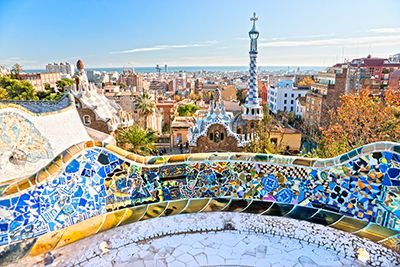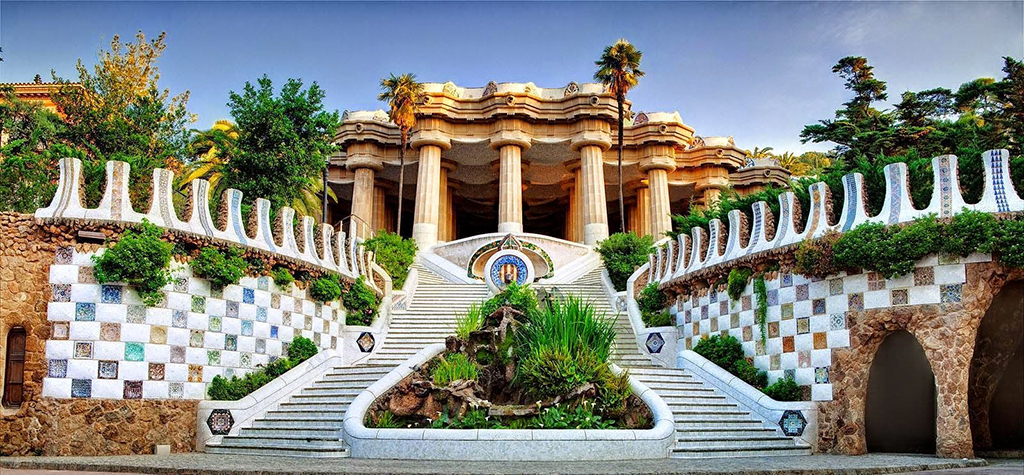Park Güell is certainly one of the more relaxing landmarks on the Gaudi trail across the streets of Barcelona as it is here that you might find a moment's peace and quiet. One can nestle themselves amongst some of the many palm trees and look out across the city's beautiful skyline.
It seems distinctly fitting that an artist who took so much inspiration from nature for his work would help to create a park in his home city. Gaudi first moved to Barcelona as a young man with dreams and aspirations but could never have envisaged leaving such a huge legacy behind, even more so that it still remains much loved and famous a century later. His brother had moved with him from their parental home in order to pursue a medical career, with Antoni already knew he would become an artist, but was not yet entirely aware in which discipline it would be. His time at the School of Architecture, naturally, would help him to make his mind up but he remained a highly flexible and open minded artist throughout his lifetime. He was by no means just an architect, with successful work in furniture, drawing and interior design also providing highlights within his extensive and varied career. Park Güell was to provide a stern challenge to the artist's imagination as when he took over the project there was no vegetation, just a sloping, barren landscape. He saw this as a blank canvas.
It would be wrong to assume that the project's donor, Eusebi Güell, was interested in giving something to the city of Barcelona for its own benefit. He had planned a suburban colony for the super rich which was intended to comprise a number of luxury apartments in which only a select few would be allowed to buy and live. Thankfully, the project changed over time and is now open to all as a public park (the park was planned for, but with elements of it private). One of the few buildings that was actually constructed is now used as the Gaudí House Museum and the artist lived there himself for many years. Besides the apartments, Gaudi was also tasked with producing plans for all of the utilities that would be required as well as landscapes gardens which surrounded the flats plus features to fill the rest of this overall area. It was a considerable untaking for him, and one that he required the use of some of his assistants in order to achieve on time. Whilst the majority of the building work was never completed, the end result remains a major highlight within the city of Barcelona.
Industrialisation was taking over the European continent during the lifetime of Gaudi and many art-conscious individuals were growing concerned by the direction being taken by modern society. The negative impact was seen in the replacement of geniune crafts with more efficient mechanical production as well as the dirtier, darker environmental impact found across the more industrialised cities. Güell saw a public park as an opportunity to counter balance this, whilst the private apartments could help to finance the overall project and also further establish his business connections within the city. Güell had also spent time in England prior to commissioning this project and was taken aback by the beauty of many gardens found within this country as well as witnessing the faster pace of industrialisation being undertaken in some of it's larger cities. William Morris may also have come to his attention, just as he did Gaudi's, with his passionate attempts to produce a revival of traditional craft techniques. He was seen by many as a beacon of hope within the art world.
About the Park
This large expanse of land spreads to over 19 hectares wide, and the majority of it is available to the public for free. One area contains a number of sculptured highlights and this requires a ticket. As with the majority of the major attractions in the city of Barcelona, you can normally purchase access to all of these venues on a single ticket, which can also be purchased online prior to your visit. Most internet-savvy tourists will take advantage of these opportunities in order to save a small amount of money as well as avoiding the stress of long queues during their holiday. Efforts have also been made to cap the number of visitors at any one time in order to avoid too much wear and tear to the extraordinary features of the park, which are, after all, part of the UNESCO works of Antoni Gaudi. Preservation also helps to protect the future of the city, by keeping its key landmarks in good order.
Despite the apartments being built for the rich and famous of Barcelona, Gaudi saw this project as an opportunity to continue his campaign of giving back to the people. It would be this public area that ultimately was fulfilled and this remains very much to the benefit of the city's residents plus its visitors. Perhaps there is a contradiction in building a safe environment for the rich to live, whilst also trying to ensure that it was treated as another suburb of the city, not separating the rich from the poor. Some of the desire for a social conscience was inspired by events in England where a number of key individuals were attempting to amend society to make it fairer and more equal.





